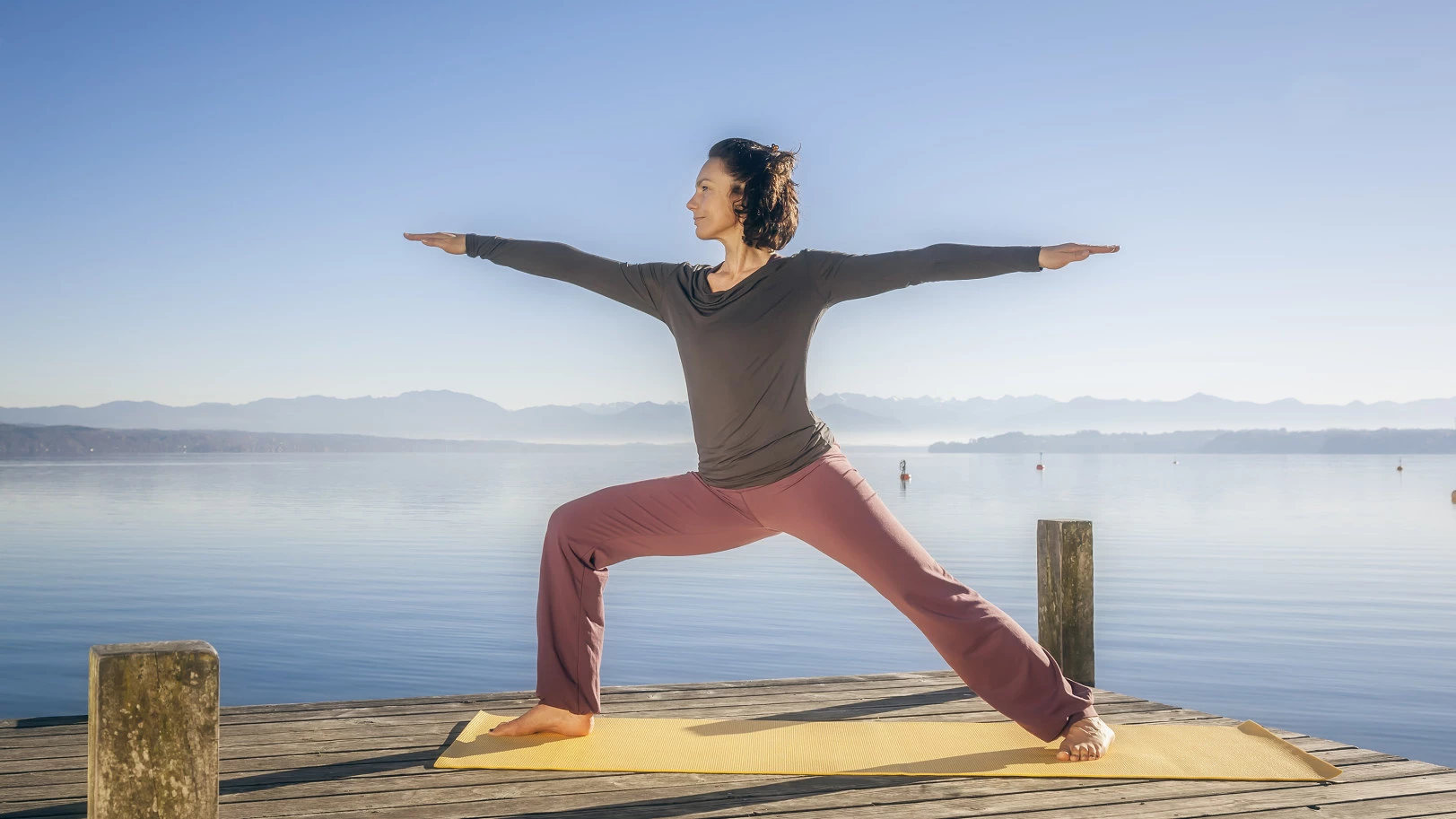Virabhadrasana II: The Quiet Warrior

Patanjali’s Yoga Sutras state that asana (the physical postures of yoga) should be “steady and comfortable,” “firm and soft” or “steady and easy,” depending on the translation. All these descriptions add up to a quiet balance between the energetic and the calm.
Challenges with Virabhadrasana II (Warrior II Pose)
About 10 years ago, Yoga Journal ran an article that queried well-known yoga teachers about their least favorite poses. Each teacher listed three poses, and Virabhadrasana II made it onto almost every list. Many years ago, I would have heartily agreed. For many years, Virabhadrasana II was a monumental struggle for me—my whole body trembled as my burning bent leg bore most of my weight. Breathing easily was a joke, as all my muscles tightened around my skeleton just to keep me upright.
However, when practiced with alignment awareness, Virabhadrasana II embodies the seemingly opposing qualities of energy and calm. While for many people, Virabhadrasana II seems to be all energy and no calm; when one’s structure is aligned in a self-supporting way, calm comes naturally.

Here’s why: For years I learned, practiced and taught that in all standing poses, the pelvis should be aligned so that the pelvic bones were even with each other. A common image to describe this was that the pelvis “should be aligned as if the body is wedged between two parallel plates of glass.”
About 20 years ago, I discovered that Warrior II didn’t have to be as difficult as I was making it. While practicing an extended version of the yoga pose in a class, I allowed the hip of my back leg to roll forward, I felt a sense of grounded stability that I had never felt before. In this alignment, I could actually feel steady and comfortable. My upper body softened and my breath became deep and satisfying. For the first time, Virabhadrasana II felt simultaneously invigorating and calming.
Not only does this alignment create a more peaceful yoga pose, it also keeps the sacroiliac joint in its healthiest alignment, with the sacrum and ilium in structural agreement. I can no longer practice the “plates of glass” alignment without injuring my sacroiliac joint, and I certainly no longer teach it.
How to Practice Warrior II (Virabhadrasana II)
Begin by standing on a nonskid mat with your feet about a leg’s length apart. Turn your right leg—foot, shin, knee and thigh—out 90 degrees. Turn your left foot toward the right foot 10 to 20 degrees. Slowly rotate your left leg and pelvis inward until you feel solid grounding through your left leg. In one sweeping motion, lift your arms out in front of you to chest level, then extend them out to the sides. Widen both the chest and upper back as you reach your arms out wide. Ground through your left foot as you bend your right knee, tracking the knee straight out. If your knee extends out in front of your heel, widen your stance so that your right shin stays vertical.
In order for the yoga pose to feel steady and comfortable, your legs must support you equally. If you have lost connection to the back leg, slowly roll the pelvis forward and back until you find the rotation that best supports your back foot to root itself into the floor. Elongate your left leg out of the pelvis and into the floor. Let your lower body release down into the feet and allow the abdomen and upper body to softly expand. Take care to keep your torso centered over your legs, as it can tend to extend out over the bent knee. This will cause the front leg to take the lion’s share of your body weight, which leads to fatigue.
Take 5 to 10 breaths. Imagine expanding the inhalation to the far reaches of the body, and settling into the ground as you exhale.
Push into the floor with both feet to straighten your right knee and come back to standing upright. Turn your feet so that they are parallel to each other. Relax your arms at your sides or place your hands together at chest level. Bend your knees slightly and let your weight sink into your feet. Rest here for a few breaths before turning to your second side.
There are many ways to be a warrior. The yogic model teaches us about the balance between grounded stability and buoyant expansion. When we align our skeletal structure with precision and awareness, our muscles do not have to work so hard to keep us upright. Instead, they stream along the bones, allowing for a clear flow of energy. Then, we become a conduit between earth and sky.
Reprinted with permission from Hugger Mugger Yoga Products
 Charlotte Bell began practicing yoga in 1982 and began teaching in 1986. She was certified by B.K.S. Iyengar in 1989 following a trip to Pune. In 1986, she began practicing Insight Meditation with her mentors Pujari and Abhilasha Keays. Her asana classes blend mindfulness with physical movement. Charlotte writes a column for Catalyst Magazine and serves as editor for Yoga U Online. She is the author of two books: Mindful Yoga, Mindful Life and Yoga for Meditators, both published by Rodmell Press. She also edits Hugger Mugger Yoga Products¹ blog and is a founding board member for GreenTREE Yoga, a non-profit that brings yoga to underserved populations. A lifelong musician, she plays oboe and English horn in the Salt Lake Symphony and the folk sextet Red Rock Rondo whose 2010 PBS music special won two Emmys.
Charlotte Bell began practicing yoga in 1982 and began teaching in 1986. She was certified by B.K.S. Iyengar in 1989 following a trip to Pune. In 1986, she began practicing Insight Meditation with her mentors Pujari and Abhilasha Keays. Her asana classes blend mindfulness with physical movement. Charlotte writes a column for Catalyst Magazine and serves as editor for Yoga U Online. She is the author of two books: Mindful Yoga, Mindful Life and Yoga for Meditators, both published by Rodmell Press. She also edits Hugger Mugger Yoga Products¹ blog and is a founding board member for GreenTREE Yoga, a non-profit that brings yoga to underserved populations. A lifelong musician, she plays oboe and English horn in the Salt Lake Symphony and the folk sextet Red Rock Rondo whose 2010 PBS music special won two Emmys.



